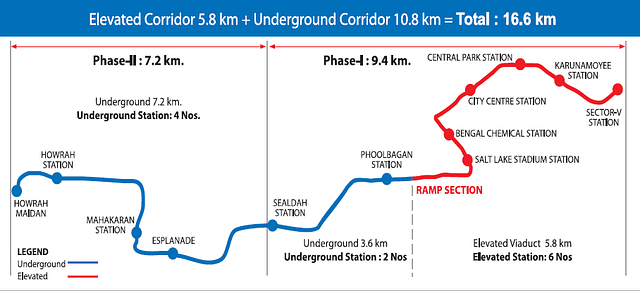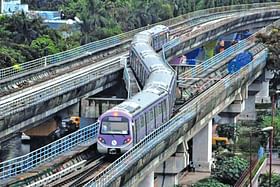The Indian Railways is making significant progress in completing the remaining work on India’s first underwater metro network, an integral part of Kolkata Metro’s East-West corridor.
This underwater corridor spans from Howrah Maidan to Esplanade, with the stations along this route nearly prepared for inauguration.
On a recent inspection, Jaya Varma Sinha, the Chairperson and Chief Executive Officer of the Railway Board, evaluated the Howrah Maidan to Esplanade stretch of the East-West Metro.
Embarking on a metro journey beneath the Hooghly River, Sinha, accompanied by P Uday Kumar Reddy, General Manager of Metro Railway, and senior officials from Metro and Kolkata Metro Rail Corporation Ltd (KMRCL), assessed the readiness of the infrastructure.
Sinha’s inspection included travelling in the motorman’s cabin from Howrah Maidan to Howrah Station and scrutinising passenger interchange points between Metro Railway, Eastern Railway and South Eastern Railway.
Following the inspection, she directed officials to coordinate efforts to facilitate seamless passenger interchange among the three railways.
The 4.8-km-long East-West Metro stretch from Howrah Maidan to Esplanade is anticipated to open to the public next month, complementing the existing operational Sealdah to Salt Lake Sector V stretch of the corridor.
Upon the full operationalisation of the entire corridor, three new stations will augment the network — Howrah Maidan, Howrah Station Complex, and BBD Bagh (Mahakaran). Remarkably, the Howrah Metro station is poised to become the deepest metro station in India.
India’s First Underwater Metro Service
India’s first underwater metro service is part of Kolkata’s East-West Corridor Project. The East-West Metro Project will link Sector V with the Howrah Maidan on the other side of the Hooghly River. It is being built for Rs 8,600 crore.
The key portion of the project is a 520-metre underwater tunnel, which is located in the 10.8 km long underground section. The underwater metro train has been compared to the Eurostar, which connects London and Paris.
The commuters will move quickly through the water, covering roughly 500 metres in less than a minute.
When completely operational, trains will travel through the river tunnels at 80 kmph and take 6 minutes to get from Howrah Maidan to Esplanade.
In 2017, the tunnelling project under the Hooghly river bed was successfully finished by construction major Afcons.
The underwater section will consist of twin tunnels made of 1.4 m-wide concrete rings. The tunnels include hydrophilic gaskets to further prevent water from getting inside.
Leading design firms like Atkins, Systra, and Tunnel Consult collaborated on the project.
Tunnel boring machines (TBMs) made by Herrenknecht were ordered. In the event of even a small water intrusion, the TBM would shut down like a submarine. British safety regulations were observed.
Trains will operate 26 metres below ground level at the tunnel’s bottom, which is 36 metres from the water’s surface.

Delays In The Project
The project’s foundation stone was placed in February 2009, and its completion date was set for October 2014. Realignment caused the work to stop from 2012 to 2015. Weak geology and a crowded topography caused many difficulties for East-West Metro Corridor.
On 31 August 2019, a tunnel boring equipment struck an aquifer, causing severe earth subsidence and the collapse of numerous nearby buildings.
The project was initially expected to be completed by December 2021, but has been delayed because of accidents that occurred at Bowbazar in central Kolkata while tunnelling work was being done.
In May, nearly three years after a similar event there, numerous residences experienced cracks while underground work was being done.


